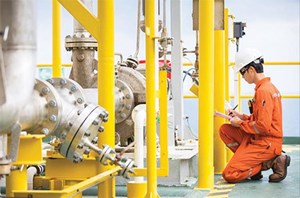Upgrade your facility tech to improve maintenance and worker safety
The oil and gas (O&G) industry has been slow historically to adopt new technology. This makes sense—globally, roughly 40% of crude oil and natural gas production sites have been in use for more than 25 years.
But it’s time for a digital transformation that will help make the O&G industry safer and more efficient. This transformation is more important than ever with severe weather events on the rise. These natural hazards can damage or incapacitate facilities, disrupting the supply chain and putting workers at risk.
To adopt innovative digital tools to protect workers and assets, O&G companies need the right company culture. In this article, then, we’ll start with a look at the internal mechanisms holding back digital transformation in the O&G industry.
There are no simple solutions to these issues but collaborating with external partners offers a path forward. To that end, we’ll explain why O&G companies should partner with companies offering strengthened Wi-Fi access, drones, and remote inspections, in order to monitor facility health, protecting workers in the process.
INTERNAL PROBLEMS HOLDING BACK TECH ADOPTION
Since the first oil boom of the 19th century, machinery and equipment advancements have been central to achieving the industry’s modern levels of operational efficiency. But innovation has slowed over the decades, and digital tech adoption has fallen by the wayside.
Indeed, a 2020 IBM report found that despite recognizing the urgency of digital innovation, companies across the industry lack effective strategies to realize their innovation goals. Breaking down this report will help frame both the roadblocks to digital tech adoption and the solutions available to break through.
By the numbers, IBM’s research paints a concerning portrait of the digital innovation landscape. For instance, 82% of O&G executives believe that modern tech is central to their success in the next three years—a critical period in the race to combat and adapt to the effects of climate change. However, only 41% say they’re executing an innovation strategy that can lead to more effective value creation.
- Where do these innovation problems stem from? As IBM’s researchers argue, the industry’s difficulties stem from organizational weaknesses in areas, such as teamwork and collaboration. Of the O&G executives surveyed:
- 67% value teamwork, but only 52% rate it as an organizational strength.
- 53% think internal collaboration is important, but only 37% see it as their company’s strong suit.
- 39% understand the need to work with external partners, but only 25% think their company does it well.
When teams struggle with internal communication, they can be slow to agree on innovative digital solutions. Even when companies have dedicated innovation teams, poor synergy with business teams can stop new tech adoption in its tracks.
Tech innovation shouldn’t happen in a silo, though: innovation requires collaboration with external partners, as well as internal ones, Fig. 1. And the IBM report shows that O&G industry leaders excel in both these areas. Compared to just 30% of regular companies, nearly 75% of industry giants engage in the kind of peer-to-peer and cross-departmental collaboration and teamwork needed for robust innovation.
The result is clear: when O&G companies invest in creating a culture of collaboration, they pave the way for high-quality digital advancements. And as IBM points out, industry leaders already have the infrastructure to support external partnerships. For example:
- Shell’s TechWorks program collaborates with external start-ups to address specific operational challenges.
- Equinor Ventures (formerly Statoil Technology Invest) invests in start-ups with cutting-edge tech that can benefit both Equinor and the O&G industry.
The industry at large needs to follow the examples of companies at the forefront of digital innovation. With facility health and worker safety on the line, O&G business leaders should invest in tech and infrastructure being developed by knowledgeable partners.
Thankfully, digital solutions exist that provide necessary boosts to operational efficiencies. Let’s look how three technologies—strengthened Wi-Fi access, drones, and remote inspections—can improve facility maintenance and worker safety.
#1: OFFSHORE FACILITIES NEED STRONG WI-FI ACCESS
Wi-Fi connectivity is a core part of any digital transformation. Offshore facilities, in particular, need strong Wi-Fi connections to transmit data to onshore teams from anywhere on the platform.
With a high-bandwidth Wi-Fi connection, offshore workers can transmit near-real-time information on facility health to maximize maintenance efficiency. Because a reliable connection can be used throughout a platform or vessel, workers can quickly alert responders about equipment failures, improving response times and overall worker safety.
Despite the importance of Wi-Fi connectivity, many facility operators have been slow to strengthen their connections. Operators may not recognize the industry benefits of wireless Internet integration, and legacy facilities can be difficult to retrofit.
Companies such as Speedcast specialize in fully managed remote communications, customized for offshore O&G sites. Because Speedcast handles setup, operators can worry less about implementation and look forward to what a strong wireless internet connection has to offer.
#2: IN POOR CONDITIONS, DRONES CAN MONITOR/COLLECT DATA
Severe weather can make it difficult for workers to access and monitor facilities. With a 360o aerial perspective, drones can collect and transit data more efficiently than a human moving around a site. More efficient data collection means that drones can identify facility and equipment issues before they become serious, preventing potentially disastrous supply chain disruptions.
When facility operators use more drones, they’re also investing in the safety of their workers. With fewer people needed on site, fewer workers will be placed in extreme weather conditions. The O&G industry isn’t a stranger to drone technology. In fact, many major companies have already invested in drones for a number of uses.
Gazprom, for example, uses drones in upstream projects to help with asset monitoring in extreme cold. Chevron uses drones outfitted with augmented reality technology to conduct facility inspections. And Equinor has integrated drones into their North Sea operations, recently making headlines after opening the world’s first fully unmanned production platform.
#3: REMOTE VIDEO TECHNOLOGY CAN GAUGE STRUCTURAL INTEGRITY
For facility matters that require expert attention, remote video technology can eliminate the need to send more than one person to isolated sites in harsh conditions, Fig. 2.
Inspections are a helpful use case. Traditionally, inspectors are physically present, usually accompanied by a co-worker and some facility crew members. In contrast, remote inspections only need a single on-site person to use a handheld device camera, to show a remote inspector points of interest over video. Companies such as Blitzz specialize in industry-specific remote solutions for inspectors and other subject matter experts (SMEs).
Remote video technology also reduces the need for rework, which limits future downtime and prevents safety issues from cropping up. These problems can be costly for O&G companies. For example, if well casings or pipeline segments are incorrectly installed, the entire facility may need to be shut down, which impacts the bottom line across all streams.
With inspectors and other SMEs in high demand, their time is precious. When experts aren’t spending time traveling between sites, they can direct their full attention to the task at hand. That means greater accuracy, higher efficiency, and fewer disruptions. If a task does need redoing, there’s no time wasted waiting for an SME to drive or fly over—inspectors are just a call away.
ADOPT NEW TECHNOLOGY TO PREPARE FOR THE FUTURE
Industry leaders are outpacing competitors in leveraging technologies like the ones we’ve looked at. Of the leaders that IBM surveyed:
- 67% use the Internet of Things, which includes technologies like drones.
- 65% use cloud computing, which requires stable WiFi access.
- 56% use mobile tech and apps, which are necessary for remote video inspections and audits.
Using new technologies isn’t the only piece of the puzzle, however. To adapt to a tech-based future, companies will need to foster a culture of innovation that encourages teamwork, empowerment, and risk-taking.
Adopting new technologies can be a slow process, but the rise in severe weather events makes technology critical to guard against facility damage and on-site injuries. And in a tech-based future, companies may need to adopt new technology early to stay competitive.

- Advancing offshore decarbonization through electrification of FPSOs (March 2024)
- Digital transformation/Late-life optimization: Harnessing data-driven strategies for late-life optimization (March 2024)
- The reserves replacement dilemma: Can intelligent digital technologies fill the supply gap? (March 2024)
- Digital tool kit enhances real-time decision-making to improve drilling efficiency and performance (February 2024)
- Digital transformation: Digital twins help to make the invisible, visible in Indonesia’s energy industry (January 2024)
- Digital transformation: A breakthrough year for digitalization in the offshore sector (January 2024)




